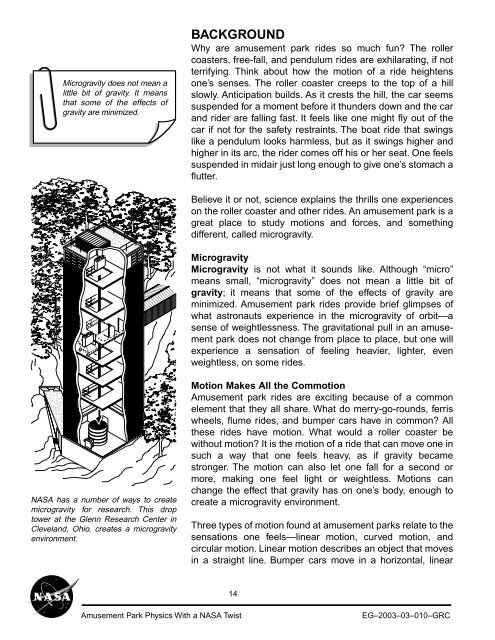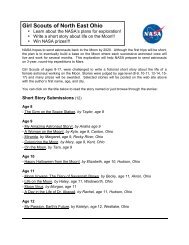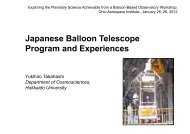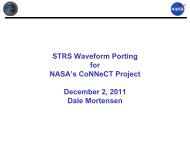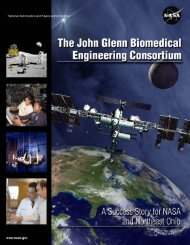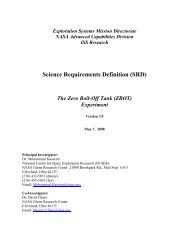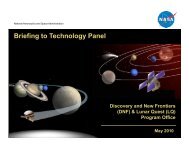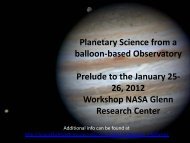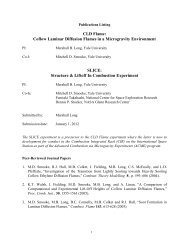Amusement Park Physics With a NASA Twist - Space Flight Systems ...
Amusement Park Physics With a NASA Twist - Space Flight Systems ...
Amusement Park Physics With a NASA Twist - Space Flight Systems ...
Create successful ePaper yourself
Turn your PDF publications into a flip-book with our unique Google optimized e-Paper software.
Microgravity does not mean a<br />
little bit of gravity. It means<br />
that some of the effects of<br />
gravity are minimized.<br />
BACKGROUND<br />
Why are amusement park rides so much fun The roller<br />
coasters, free-fall, and pendulum rides are exhilarating, if not<br />
terrifying. Think about how the motion of a ride heightens<br />
one’s senses. The roller coaster creeps to the top of a hill<br />
slowly. Anticipation builds. As it crests the hill, the car seems<br />
suspended for a moment before it thunders down and the car<br />
and rider are falling fast. It feels like one might fly out of the<br />
car if not for the safety restraints. The boat ride that swings<br />
like a pendulum looks harmless, but as it swings higher and<br />
higher in its arc, the rider comes off his or her seat. One feels<br />
suspended in midair just long enough to give one’s stomach a<br />
flutter.<br />
Believe it or not, science explains the thrills one experiences<br />
on the roller coaster and other rides. An amusement park is a<br />
great place to study motions and forces, and something<br />
different, called microgravity.<br />
Microgravity<br />
Microgravity is not what it sounds like. Although “micro”<br />
means small, “microgravity” does not mean a little bit of<br />
gravity; it means that some of the effects of gravity are<br />
minimized. <strong>Amusement</strong> park rides provide brief glimpses of<br />
what astronauts experience in the microgravity of orbit—a<br />
sense of weightlessness. The gravitational pull in an amusement<br />
park does not change from place to place, but one will<br />
experience a sensation of feeling heavier, lighter, even<br />
weightless, on some rides.<br />
<strong>NASA</strong> has a number of ways to create<br />
microgravity for research. This drop<br />
tower at the Glenn Research Center in<br />
Cleveland, Ohio, creates a microgravity<br />
environment.<br />
Motion Makes All the Commotion<br />
<strong>Amusement</strong> park rides are exciting because of a common<br />
element that they all share. What do merry-go-rounds, ferris<br />
wheels, flume rides, and bumper cars have in common All<br />
these rides have motion. What would a roller coaster be<br />
without motion It is the motion of a ride that can move one in<br />
such a way that one feels heavy, as if gravity became<br />
stronger. The motion can also let one fall for a second or<br />
more, making one feel light or weightless. Motions can<br />
change the effect that gravity has on one’s body, enough to<br />
create a microgravity environment.<br />
Three types of motion found at amusement parks relate to the<br />
sensations one feels—linear motion, curved motion, and<br />
circular motion. Linear motion describes an object that moves<br />
in a straight line. Bumper cars move in a horizontal, linear<br />
14<br />
<strong>Amusement</strong> <strong>Park</strong> <strong>Physics</strong> <strong>With</strong> a <strong>NASA</strong> <strong>Twist</strong><br />
EG–2003–03–010–GRC


